Physical Address
304 North Cardinal St.
Dorchester Center, MA 02124
The middle cluneal nerve (MCN) has long been overlooked as a cause of low back pain. As the understanding of the role of the MCN becomes more clear, the range of treatment options, including peripheral nerve stimulation (PNS), has increased.
Pain caused by MCN entrapment (MCN-E) can often be overlooked during a patient’s initial presentation. The patient will complain of pain in the buttock ( Fig. 20.1 ). There is typically tenderness inferior to or near the posterior superior iliac spine (PSIS) ( Fig. 20.2 ). The pain may be in the lower back as well as the leg and can be exacerbated by changes in posture. A positive Tinel’s upon palpation of the nerve inferior to the PSIS or lateral to the sacral foramen may be present. Like the superior cluneal nerve entrapment, MCN-E may result in persistent pain after back surgery (“failed back surgery syndrome”). Matsumoto et al. observed that 27% of patients reporting residual pain after lumbar decompression surgery had residual symptoms controlled by additional peripheral nerve blocks.
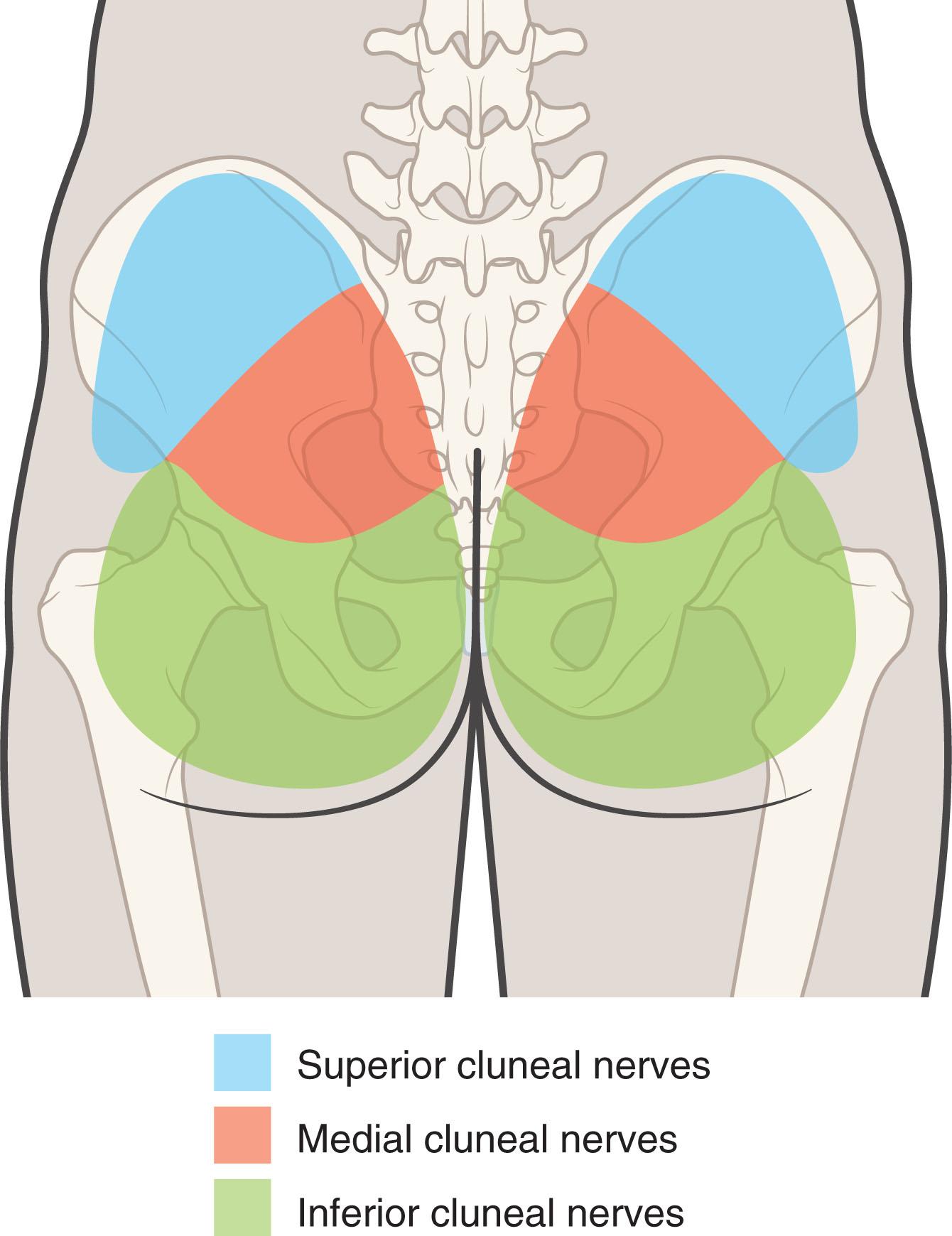
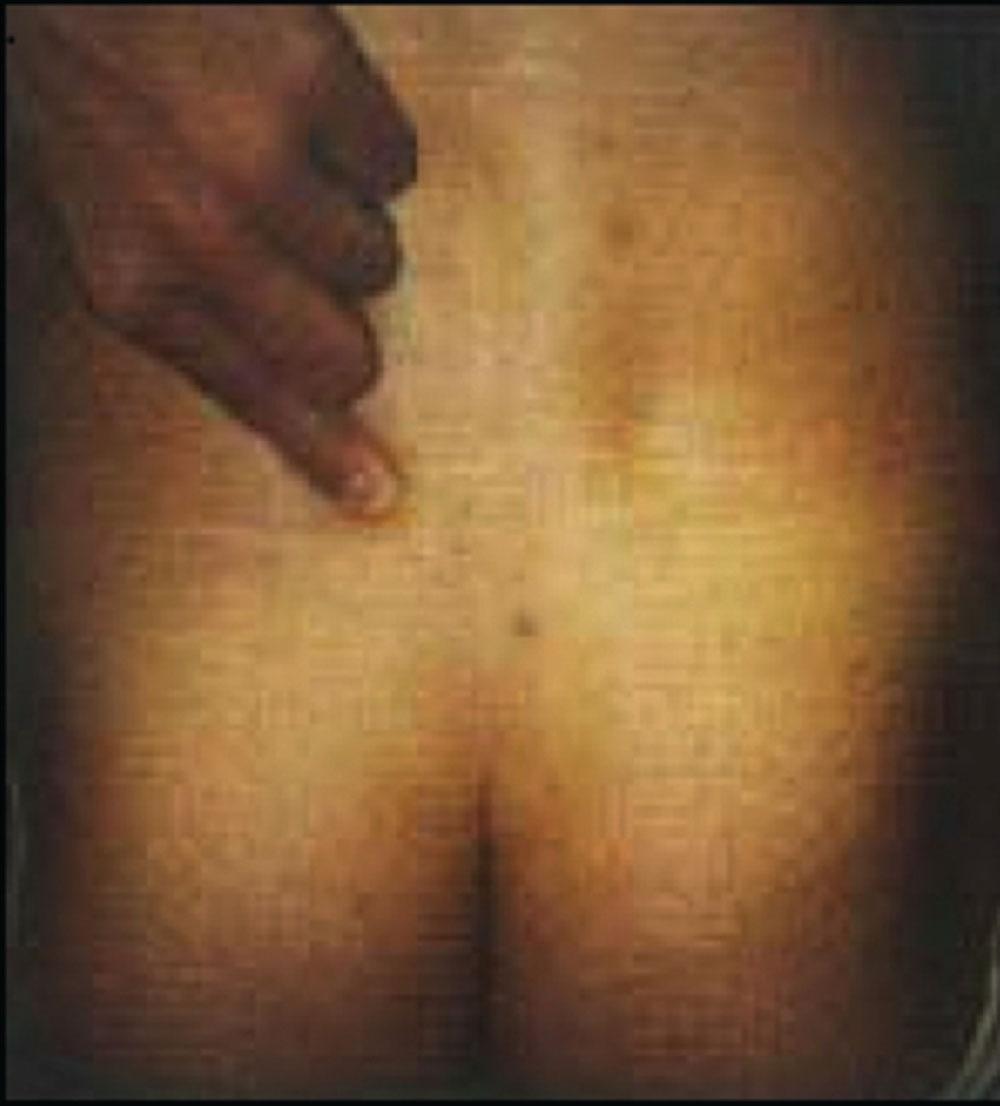
There may be confusion between the terms “middle cluneal nerve” and “medial cluneal nerve.” The MCN is derived from the sacral spine, whereas the majority of the superior medial cluneal nerves (or medial superior cluneal nerves) are derived from the lumbar spine. The medial most branches of the superior cluneal nerves are referred to as the “superior medial cluneal nerves,” followed laterally by the “superior middle cluneal nerves” and lastly the “superior lateral cluneal nerves.”
The MCN is a branch of the posterior ramus of the sacral nerve roots, arising from the dorsal rami of the S1 to S4 at the corresponding foramina. Both the superior cluneal nerve and the MCN are purely sensory. The MCNs are generally 1.5 cm inferior to the PSIS and traverse the paraspinal muscles on the dorsal sacrum. The MCN may be entrapped as it runs under or through the long posterior sacroiliac ligament (LPSL). The nerves course horizontally to supply the skin overlying the posterior medial area of the buttock. Anatomical studies by Tubbs et al. concluded that the MCN travels superficial to the LPSL and would be less likely to become entrapped; however, Horwitz, Grob et al. and McGrath et al. demonstrated that the primary and secondary loops of the posterior sacral nerve plexus passed through or underneath the LPSL, suggesting that entrapment of the penetrating nerves within or under the ligament is a potential cause for low back pain and peripartum pelvic pain ( Fig. 20.3 ).
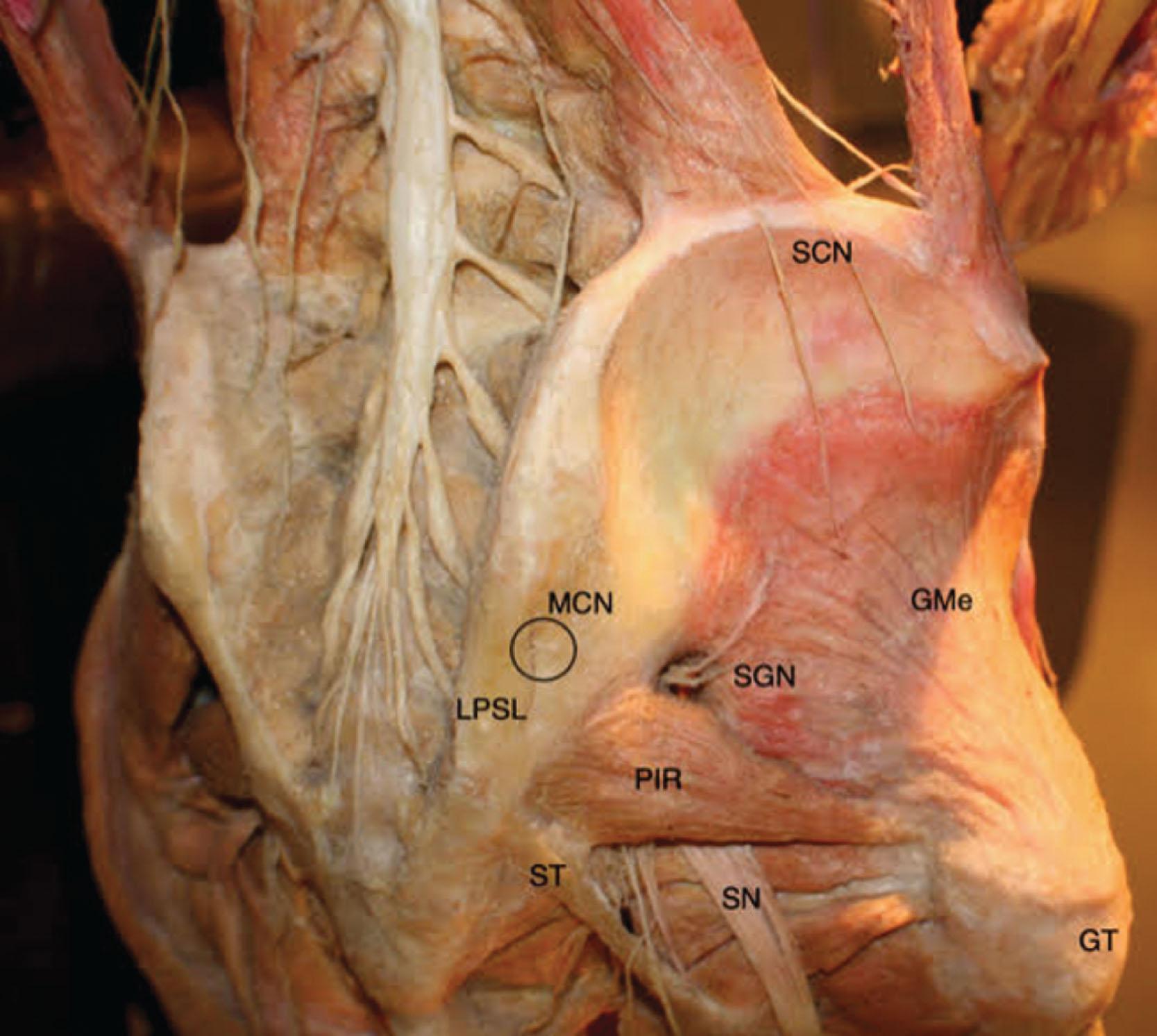
Konno et al. evaluated 30 hemipelves and identified a total of 64 MCN branches composed of the S1–S4 dorsal rami. The distances from the PSIS to the dorsal rami traversing over or under the LPSL were approximately 20 mm for S1, 23 mm for S2, 34 mm for S3, and 41 mm for S4. Ten penetrating branches were lateral branches of the dorsal sacral rami and were mostly derived from the S2 foramina. This occurred at an average distance from the midline at 34.5 mm, and the average cephalocaudal distance from the PSIS to the penetration was 23.2 mm. The average width of the MCN branch was 1.6 mm, and this was measured at the point where it traversed the LPSL. There was marked narrowing from constriction under the LPSL in four of the 10 MCN branches that passed under the LPSL. It was found that some of the penetrating MCN branches extended a thin nerve fiber into the sacroiliac (SI) joint, and there was an anastomosis found between the MCN and the superior cluneal nerve in the subcutaneous tissue of the buttocks, as well as communicating branches from the MCN to the superior gluteal nerve (see Fig. 20.3 ).
Konno et al. also identified entrapment of the MCN under the LPSL in 13% of cadavers and agreed with the concept that LPSL is a potential pain generator. It is commonly believed that the LPSL plays a large role in SI joint pain.
Diagnosis of MCN-E is typically made by palpation of the PSIS or LPSL, producing marked tenderness and provocation of symptoms accompanied by relief after local anesthetic injection. The MCN tender point is on the LPSL and located approximately 40 mm caudal to the PSIS.
Radiology and electromyography cannot diagnose MCN-E neuropathy, yet they can exclude other pathologies, such as disc herniation, facet joint degeneration, tumor, and so on. In one study, five out of 30 patients with MCN pathology had referred pain in the leg in the S1 and/or S2 dermatomes. MCN deafferentation produced favorable outcomes in these patients. Posterior thigh or calf symptoms may be explained by involvement of the S1 and S2 lateral branches.
Pain related to MCN can be misdiagnosed as arthritis of the SI joint. Like the SI joint pain syndrome, there is no radiological assessment that provides concrete diagnostic information regarding the MCN. The gold standard to rule out SI pathology is a SI joint injection under fluoroscopy. The long posterior SI joint ligament resists shearing of the SI joint and can be a possible pain generator. Murukami et al. reported on the effect of injection into the periarticular region near the LPSL versus the intraarticular SI joint space in patients with SI joint pain. Out of the 25 patients studied, all the patients had relief when the LPSL was injected, and only nine out of 25 had relief when the joint was injected alone. The 16 without relief from the intraarticular injection reported complete relief when the space around the LPSL was infiltrated.
Isu et al. proposed that the diagnostic criteria of middle cluneal neuralgia be: (1) low back pain radiating to the buttocks; (2) symptoms exacerbated by changes in posture or movement; (3) a tender point 35 mm caudal to the PSIS and lateral to the edge of the iliac crest (which correlates to the nerve compression zone); (4) numbness and radiating pain in the MCN area when the tender point is compressed (Tinel’s sign); and (5) relief with MCN block.
The fluoroscopic technique for injecting the MCN relies on the location of the MCN at the lateral border of the S2 foramen ( Fig. 20.4A ). The patient is positioned prone, and the S2 sacral foramen is identified by fluoroscopy ( Fig. 20.4B ). This usually corresponds to the area of tenderness identified by Fortin for use in the “Fortin finger test” ( Fig. 20.2 ). After sterile prep and drape, local anesthetic is infiltrated subcutaneously, and then a needle (with or without a needle stimulator) is advanced to the lateral border of the S2 foramen ( Fig. 20.4C ). After negative aspiration, 1 cc of local anesthetic (with or without steroid) is injected. If the medial border of the iliac crest is overlying the target site, a contralateral oblique image will move the bone out of the way.
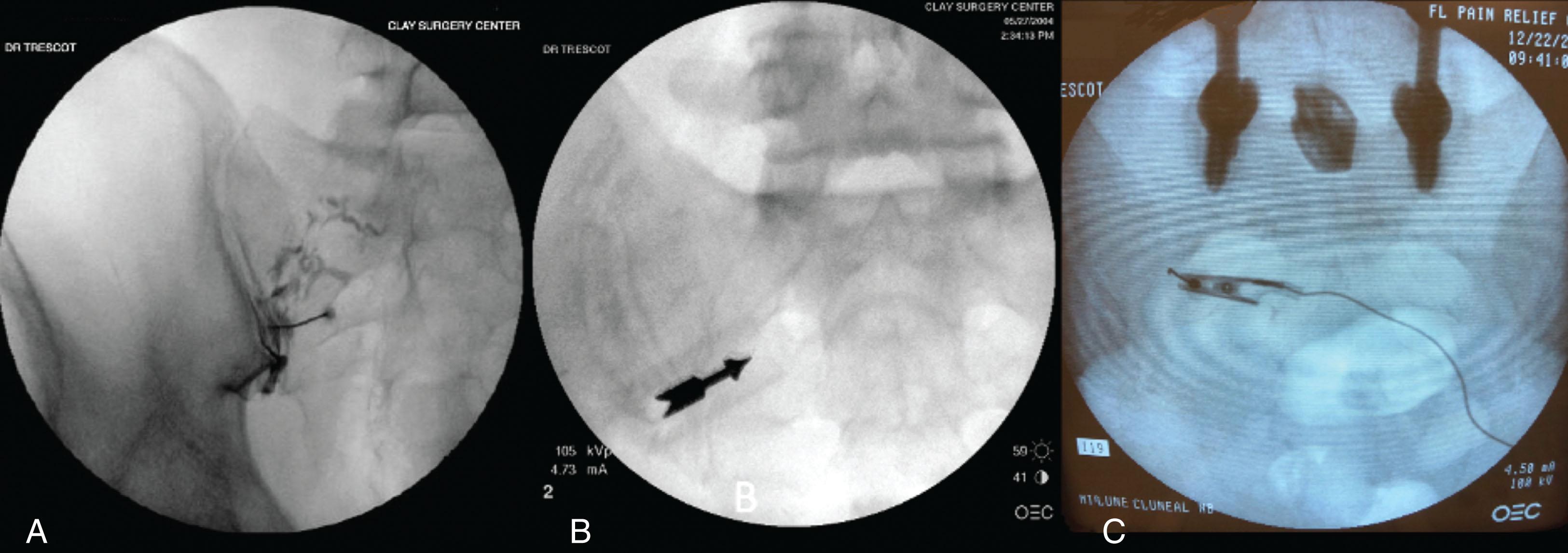
Ultrasound for MCN block has the advantage of real-time injection and soft tissue visualization. The sacral foramen may be identified by scanning the sacral bone in a longitudinal fashion. The uppermost aspect of the sacrum, the sacral alar, and the L5/S1 facet joint may be identified. Below, hypoechoic gaps in the bone may be identified as the sacral foramina starting with S1, followed by S2, and so on. Scanning lateral to the foramen, hyperechoic soft tissue comes into view, as depicted in Fig. 20.5 . One may attribute the soft tissue above and lateral to the foramen to be the exiting dorsal ramus branch of the sacral nerve, with the MCN branching off laterally and more superficial towards the LPSL and gluteal muscles.
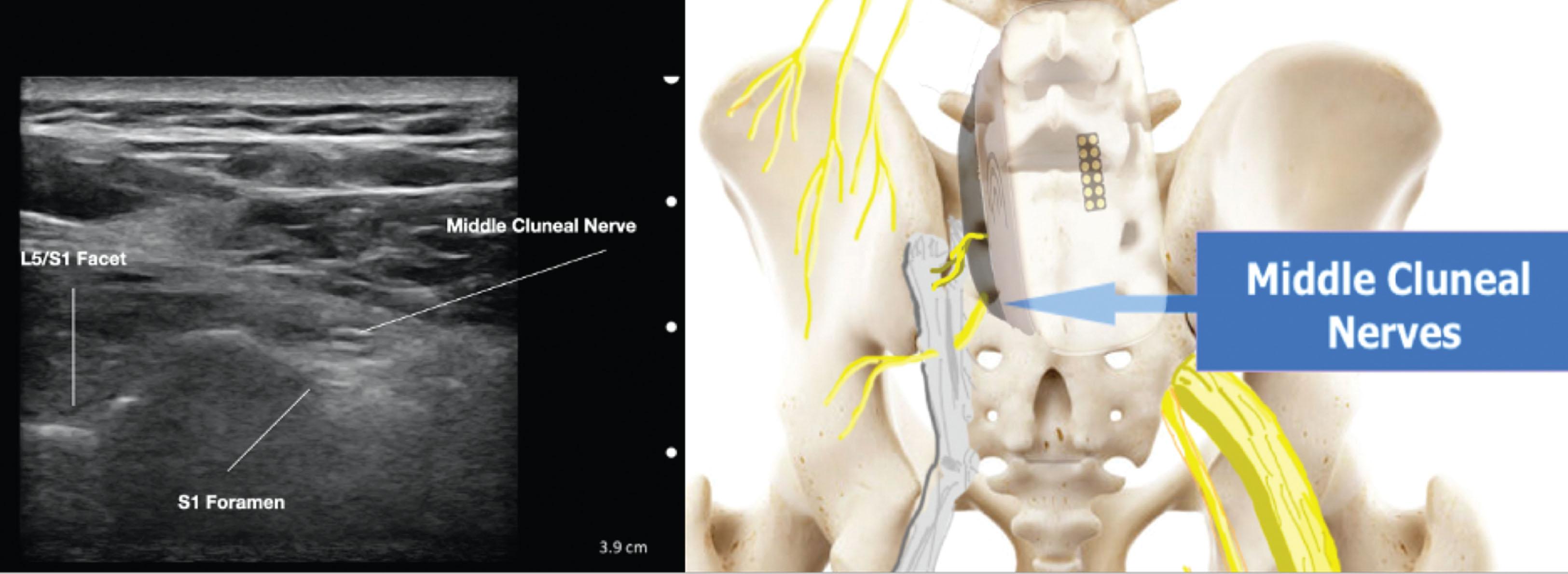
One can then gently scan laterally in a longitudinal orientation to identify the LPSL ( Fig. 20.6 ). The nerve can be injected with an in-plane approach so that the needle is placed lateral to the corresponding sacral foramen to be targeted. Alternatively, the S1 foramen can be identified in a transverse view, with the PSIS usually corresponding to the level of the first sacral foramen. This can be visualized when scanning medial to the PSIS hyperechoic superficial bony shadow ( Fig. 20.7 ).
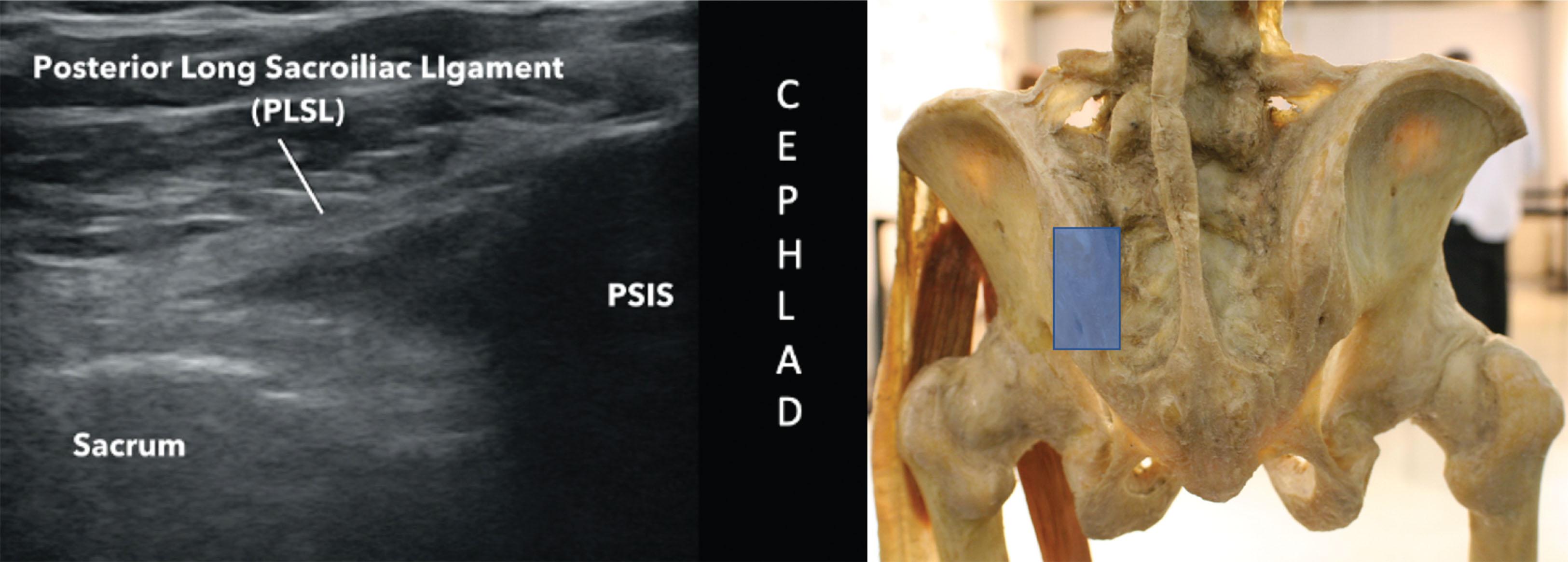
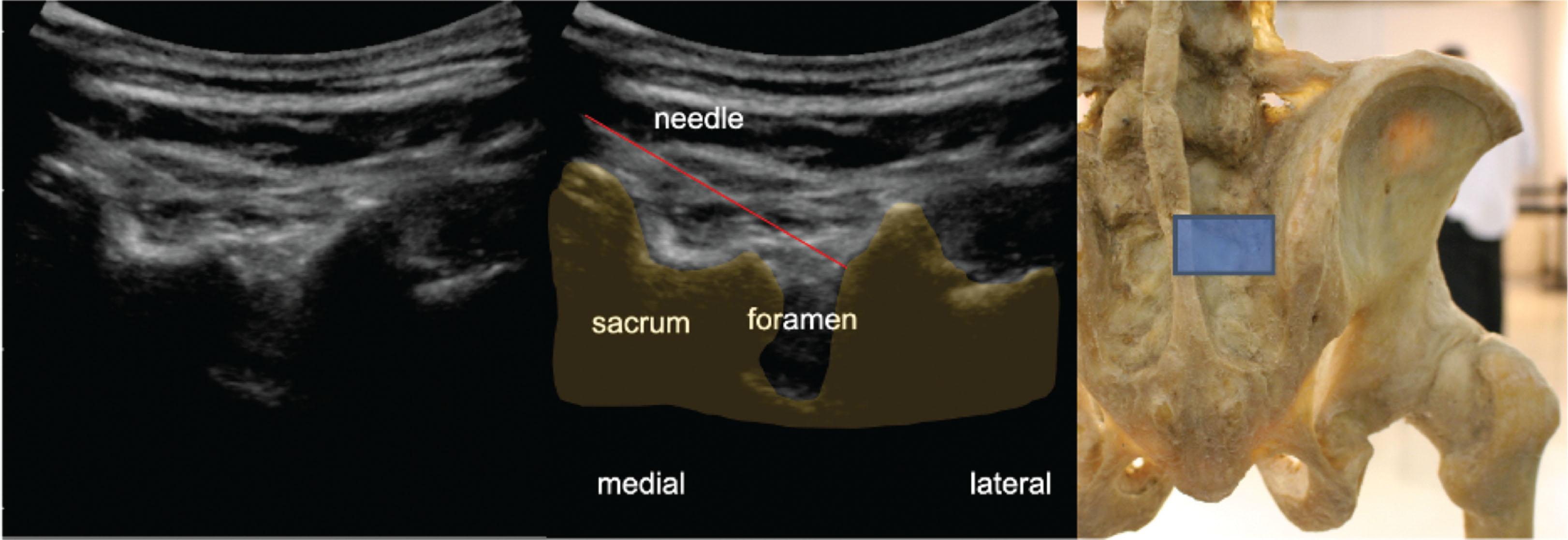
One should ideally use a low-volume local anesthetic, ranging from 0.5 mL to 1 mL, to minimize the chance of a false positive, with spread to the sacral foramen, sciatic nerve, or SI joint.
Become a Clinical Tree membership for Full access and enjoy Unlimited articles
If you are a member. Log in here